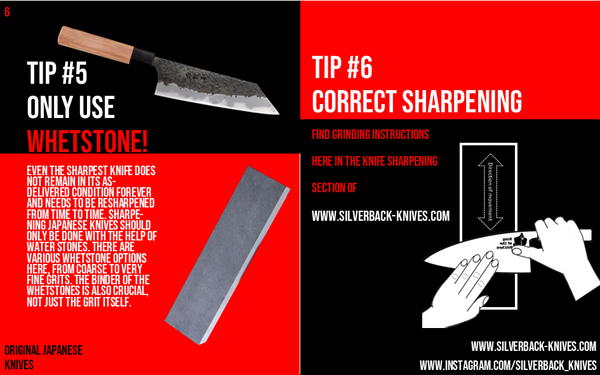Knife Care Tips
Care instructions for a long knife life
What to cut on - the cutting surface
Cleaning Japanese kitchen knives properly
Storing your knives
Japanese kitchen knife sharpening
Japanese knives - what to be careful about
A Japanese knife requires a little care and you should follow a few simple tips to enjoy it for a long time. Therefore, on this page we have compiled the summary of care and handling tips for Japanese kitchen knives for you. No matter which Japanese knife types - such as santoku knives, gyuto knives, bunka knives, nakiri knives or special knives - these tips should always be followed. We have collected these tips through our many years of experience in (almost) daily use of high-quality Japanese chef's knives, and we recommend following them. Thus, a Japanese kitchen knife or even a Japanese knife set is certainly a good investment and can be used for a lifetime.

TIP #1 Hand wash only!
High-quality Japan knives or hand-forged knives must not be put in the dishwasher! In the dishwasher, your knife will be damaged because it oxidizes and the mostly used wooden handles swell up and may detach from the blade. You should only clean your knife by hand with a fine sponge, lukewarm water and a little detergent if needed.
TIP #2 Always dry Japanese chef's knives
After rinsing, the knife should be dried immediately to prevent rust from forming. This also applies to highly rust-resistant knives, because even here, rust formation cannot be completely ruled out.

TIP #3 Flexible Cutting Pad for Japan Blades
To avoid dulling your Japanese knife blade, you should always cut on a wooden or plastic board. Boards made of metal, glass, marble or porcelain will not give way and the blade will dull faster. Soft wood boards are especially recommended.
TIP #4 Store Japanese knives properly
You can store your knives e.g. in wooden knife blocks, in the supplied knife box or wrapped in a cloth. Be sure to remove any potential mechanical impact that could scratch the knife. Magnetization of your knives by magnetic knife racks should be avoided, as magnetization of the knife steel can make sharpening your knives more difficult.

TIP #5 Water sharpening stones only!
Even the sharpest knife does not remain in its as-delivered condition forever and must be resharpened from time to time. Sharpening Japanese knives should only be done using water stones. There are various whetstone options here, from coarse to very fine grits. The binder of the whetstones is also critical, not just the grit itself.
TIP #6 Japan Knife Sharpening Properly.
Read online here: Grinding Japanese Knives

TIP #7 Never use bones or frozen food!
Frozen and hard cuttings can damage the hard and thin blade of genuine Japanese knives. A Japanese knife is not to be confused with a Chinese cleaver
TIP #8 Proper cutting with Japanese knives
Use your knife for pulling and pushing movements and let the sharp knife work for you. Do not apply too much pressure and avoid levering motions, as this could damage the blade.

TIP #9 Oil as a protective coating
Protect your blade surface with the help of food-safe oils and greases. Regular application of olive oil, for example, will protect the blade from corrosion. Depending on the Japanese knife steel, a patina will form on the blade, this is useful and desired.
TIP #10 Use the back of the blade
To move food after cutting, use the back of the blade instead of the cutting edge. This will protect the blade and keep your knife sharp longer.


